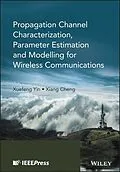A comprehensive reference giving a thorough explanation of propagation mechanisms, channel characteristics results, measurement approaches and the modelling of channels
Thoroughly covering channel characteristics and parameters, this book provides the knowledge needed to design various wireless systems, such as cellular communication systems, RFID and ad hoc wireless communication systems. It gives a detailed introduction to aspects of channels before presenting the novel estimation and modelling techniques which can be used to achieve accurate models.
To systematically guide readers through the topic, the book is organised in three distinct parts. The first part covers the fundamentals of the characterization of propagation channels, including the conventional single-input single-output (SISO) propagation channel characterization as well as its extension to multiple-input multiple-output (MIMO) cases. Part two focuses on channel measurements and channel data post-processing. Wideband channel measurements are introduced, including the equipment, technology and advantages and disadvantages of different data acquisition schemes. The channel parameter estimation methods are then presented, which include conventional spectral-based estimation, the specular-path-model based high-resolution method, and the newly derived power spectrum estimation methods. Measurement results are used to compare the performance of the different estimation methods. The third part gives a complete introduction to different modelling approaches. Among them, both scattering theoretical channel modelling and measurement-based channel modelling approaches are detailed. This part also approaches how to utilize these two modelling approaches to investigate wireless channels for conventional cellular systems and some new emerging communication systems. This three-part approach means the book caters for the requirements of the audiences at different levels, including readers needing introductory knowledge, engineers who are looking for more advanced understanding, and expert researchers in wireless system design as a reference.
- Presents technical explanations, illustrated with examples of the theory in practice
- Discusses results applied to 4G communication systems and other emerging communication systems, such as relay, CoMP, and vehicle-to-vehicle rapid time-variant channels
- Can be used as comprehensive tutorial for students or a complete reference for engineers in industry
- Includes selected illustrations in color
- Program downloads available for readers
- Companion website with program downloads for readers and presentation slides and solution manual for instructors
Essential reading for Graduate students and researchers interested in the characteristics of propagation channel, or who work in areas related to physical layer architectures, air interfaces, navigation, and wireless sensing
Autorentext
XUEFENG YIN, Tongji University, China
XIANG CHENG, Peking University, China
Klappentext
Propagation Channel Characterization, Parameter Estimation and Modelling for Wireless Communications
This book is a comprehensive reference giving a thorough explanation of propagation mechanisms, channel characteristics results, measurement approaches and the modelling of channels. Thoroughly covering channel characteristics and parameters, it provides the knowledge needed to design various wireless systems, such as cellular communication systems, RFID and ad hoc wireless communication systems. It gives a detailed introduction to various channel aspects before presenting the novel estimation and modelling techniques that can be used to achieve accurate models.
Key features:
- Presents technical explanations, illustrated with examples of the theory in practice
- Discusses results applied to 4G and 5G communication systems and other emerging communication systems, such as relay, CoMP, and vehicle-to vehicle rapid time-variant channels
- Covers in three distinct sections the fundamentals, channel measurements and data post-processing and different modelling approaches
- Features a companion website with program downloads for readers and presentation slides and a solution manual for instructors
Propagation Channel Characterization, Parameter Estimation and Modelling for Wireless Communications is essential reading for graduate students and researchers interested in the characteristics of propagation channels, or who work in areas related to physical layer architectures, air interfaces, navigation, and wireless sensing.
Inhalt
Preface xi
List of Acronyms and Symbols xiii
1 Introduction 1
1.1 Book Objective 1
1.2 The Historical Context 2
1.2.1 Importance of Channel Characterization 2
1.2.2 Single-input, Single-output Channel Models 2
1.2.3 Spatial Channel Models (SCMs) 5
1.2.4 Channel Models for 5G 6
1.2.5 Other Kinds of Channel Model 7
1.3 Book Outline 8
Bibliography 9
2 Characterization of Propagation Channels 15
2.1 Three Phenomena in Wireless Channels 15
2.2 Path Loss and Shadowing 16
2.3 Multipath Fading 18
2.4 Stochastic Characterization of Multipath Fading 22
2.4.1 Received Envelope and Phase Distribution 23
2.4.2 Envelope Level Cross Rate and Average Fade Duration 24
2.4.3 Correlation Functions 24
2.5 Duality of Multipath Fading 26
2.6 WSSUS Assumption of Multipath Fading 28
2.7 A Review of Propagation Channel Modeling 31
2.7.1 Classification of MIMO Channel Models 32
2.7.2 Classification of V2V Channel Models 35
Bibliography 38
3 Generic Channel Models 41
3.1 Channel Spread Function 43
3.2 Specular-path Model 46
3.3 Dispersive-path Model 51
3.4 Time-evolution Model 54
3.5 Power Spectral Density Model 57
3.6 Model for Keyhole Channel 68
Bibliography 73
4 Geometry-based Stochastic Channel Modeling 77
4.1 General Modeling Procedure 77
4.2 Regular-shaped Geometry-based Stochastic Models 79
4.2.1 RS-GBSMs for Conventional Cellular Communication Systems 79
4.2.2 RS-GBSMs for V2V Communication Systems 82
4.3 Irregular-shaped Geometry-based Stochastic Models 83
4.4 Simulation Models 84
4.4.1 Filter Simulation Models 86
4.4.2 Sum-of-sinusoids Simulation Models 88
4.5 Simulation Models for Non-isotropic Scattering Narrowband SISO V2V Rayleigh Fading Channels 90
4.5.1 A Two-ring SISO V2V Reference Model 91
4.5.2 SoS Simulation Models 92
Bibliography 103
5 Channel Measurements 106
5.1 Channel-sounding Equipment/System 107
5.2 Post-processing of Measurement Data 109
5.3 Impact of Phase Noise and Possible Solutions 110
5.3.1 Mitigating Phase Noise: the Sliding Window 111
5.3.2 Mitigating Phase Noise: Whitening and the SAGE algorithm 113
5.4 Directional Radiation Patterns 117
5.5 Switching-mode Selection 124
5.5.1 Switching-mode for Channel Sounding 125
5.5.2 Estimation of Doppler Frequency 126
5.5.3 Ambiguity in Parameter Estimation 129
5.5.4 Case Study: TDM-SIMO Channel Sounding with a Uniform Linear Array 130
5.5.5 Switching-mode Optimization 132
5.5.6 Simulation Studies 134
Bibliography 142
6 Deterministic Channel-parameter Estimation 145
6.1 Bartlett Beamformer 146
6.2 The MUSIC Algorithm 148
6.3 The ESPRIT and Propagator Methods 150
6.3.1 Esprit 150
6.3.2 The Propagator Algorithm 152
6.4 Maximum-likelihood Method 152
6.5 The SAGE Algori…
